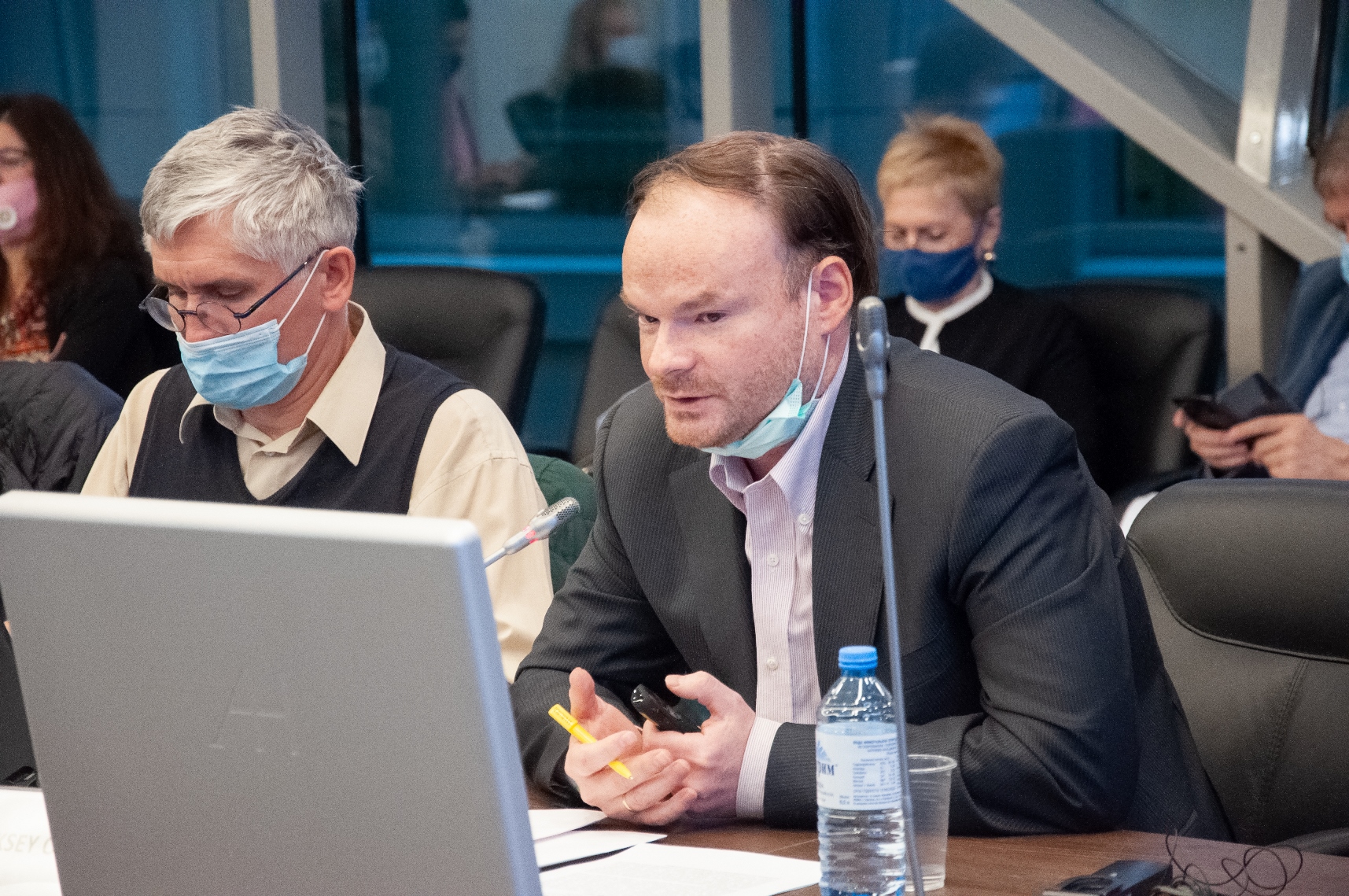Customs, Career Choices and Self-discrimination: Why Women Earn Less

Experts from the World Bank and HSE University discussed the gender gap in salaries in different countries and the impact of socio-cultural, economic and behavioural factors on differences in earnings.
The Human Capital Multidisciplinary Research Center has hosted the seminar ‘Gender Wage Inequality: World Experience.’ The event was organized by the HSE Institute for Social Policy and the World Bank. In his welcoming speech, HSE Vice Rector Ivan Prostakov remarked on the long and fruitful cooperation between HSE University and the World Bank. He added that HSE University’s cooperation with international organizations creates a dialogue that cements its position as an expert institution. Mr. Prostakov thanked the World Bank for its assistance in organizing the seminar and the opportunity to learn about the bank's expertise.

Lilia Ovcharova, HSE Vice Rector, Director of the HSE Institute for Social Policy and originator of the Human Capital Multidisciplinary Research Center, noted that the recent Nobel Prize in Economics was awarded to scientists studying the labour market. She believes that this serves as recognition of the achievements of researchers working in the field.

Renaud Seligmann, the World Bank's Country Director for the Russian Federation, spoke about the importance of human capital problems at the global level. He said that the pandemic has exacerbated the problem of gender inequality. ‘Even before the crisis started, it was clear that its negative consequences would have a greater impact on women: they lose their jobs more often, and they bear greater responsibilities for family care. Women have had to take care of sick family members and children who couldn’t attend school,’ he added.
Kathleen Beegle, Research Manager and Lead Economist in the Human Development Team of the World Bank's Development Research Group, stressed that the study of data on inequality is ongoing. She explained that the wage gap can differ depending on the methods used to study wages and eliminate the factors that affect the difference in salaries. The situation can vary significantly by country. For example, women's earnings in the Middle East and North Africa are even higher than men's, while in a number of Latin American countries, the gender gap is minimal. In sub-Saharan countries, women’s average salary is only 60% of men's.

The greatest gap is observed in low-income countries. The size of the gap also depends on the level of public sector employment, which is characterized by high salaries and insignificant gender differences; in the private sector, the situation is much worse. The difference in earnings is often explained by claiming that women work in lower-paid positions. However, even taking these factors into account, the gap in the USA remains 8–9 percentage points.
Differences in earnings cannot be explained by economic factors. Differences in non-cognitive skills, hiring tactics and career development may affect the disparity. Kathleen Beegle suggests that we should also consider unobservable factors such as flexible hours, which partially compensate for low wages. Pay discrimination can also occur in hiring when an employer prefers to hire men for high-paying jobs.
The World Bank expert considers the suggestion that low incomes are linked to the high level of women's participation in the workforce to be incorrect. There are countries that display a low difference in earnings combined with a low level of women’s employment, mainly due to national and religious factors that encourage married women to become housewives. In some countries, such as Jordan, women's work is subject to a number of restrictions, such as picking children up from school or returning home before 5 pm.
Women’s employment is often met with resistance in society. A survey conducted in a number of Asian countries showed that the percentage of people who believe that women in the workforce can destabilize a company ranges from 14% (Nepal) to 45% (Bangladesh), with figures for India and Pakistan as high as 28% and 30% respectively. Women’s employment and the size of their earnings in many regions are also limited by poor public transport infrastructure and incidents of sexual harassment on public transport.
We should talk about increasing women's mobility, their safety on public transport, developing new platforms for job hunting, and increasing men's involvement in childcare in order to increase women's opportunities in finding and getting jobs.
Aleksey Oshchepkov, Senior Research Fellow at the Centre for Labour Market Studies, says that the gap in earnings between men and women in Russia is about 30%, which is comparable to South Korea and Japan, but much higher than in the United States and Europe. Over recent decades, it has decreased by 10 percentage points.
Mr. Oshchepkov believes that segregation by profession and industry is the main factor influencing the wage gap, with women more likely to work in low-wage fields. They also work less than men. Human capital and experience play the opposite role: women are generally more educated than men, and if not for this factor, the gap could be even greater. Variables such as region of residence and marital status don’t significantly affect the wage gap.

The structure of the unexplained part of the gap requires further study. According to Alexey Oshchepkov, the return on education for women is higher than for men. Women with children have lower salaries, while men with children receive bonuses, which explains part of the gap.
Economists cannot explain a significant part of the wage gap using standard factors—this unexplained part is often linked to discrimination, but economists do not yet have any data obtained through robust and appropriate methods. Mr. Oshchepkov believes that this can be partly attributed to personal characteristics and social norms.
Natalya Yemelina, Senior Research Fellow at the Laboratory for Labour Market Studies, spoke about a study based on a meta-analysis of the gender wage gap. It showed that the unexplained part is growing and the influence of human capital factors and job characteristics is decreasing. The meta-analysis confirmed the importance of considering segregation by industry and occupation, which account for 30% of the gap, as well as the increased role of non-cognitive skills. Girls are more likely to work in education and the socio-cultural sphere, where salaries are lower than in traditionally ‘male’ professions. This leads to segregation from the start of people’s careers. But even women who graduate from the same universities as men earn lower salaries than their classmates.

The gender gap is also partly caused by a difference in working hours: on average, women in Russia work 12 hours less than men. The difference calculated in hourly earnings is lower than that in monthly earnings.
In addition, women take risks less often and are less open and willing to retrain, which can also affect their wages. According to Natalia Emelina, in order to reduce the gender wage gap, it is necessary to reduce the level of educational segregation and to increase women's emotional stability and willingness to retrain.
Olga Lazareva, Assistant Professor at the Faculty of Economic Sciences, highlighted the impact of social norms on the gender wage gap. These norms are formed early—children absorb them at home or at school under the influence of their teachers and peers. They can also change under the influence of official ideology. Established norms affect which segments of the labour market are available to women. One of the reasons for the wage gap is the glass ceiling—the low numbers of women in senior management at state institutions and private companies.
In Russia, women occupy about 40% of leadership positions—more than in France, the United States and other developed countries—but this figure varies greatly in different sectors of the economy.
There are many women in senior positions in education and medicine, but few in other industries. The leaders of large companies and institutions are rarely women. The sentiment that men make better leaders than women is more widespread in Russia than in other countries, and has been growing in recent years. This harms women’s chances of taking up senior positions and getting high-paying jobs.
Anna Lukyanova, Senior Research Fellow at the Centre for Labour Market Studies, spoke about the impact of digitalization on the wage gap. The digital skills gap between men and women in Russia is small, which brings it closer to developed countries. In 2018, more than 80% of working women and more than 75% of men regularly used a computer. Most men and women have average-level digital skills (64% of employed women and 68% of men in 2018). However, only 0.6% of employed women have the highest level of computer skills, compared to 3.3% of men. At the same time, significantly fewer working women have low-level digital skills (10% versus 18% for men).
When a computer skills variable is added to the Mincer earnings function, digitalization does not become a new source of discrimination: men and women receive approximately the same bonuses for new competencies and get promoted to more digitalized professions, said Anna Lukyanova.
Kathleen Beegle thanked the participants for sharing their ideas. She noted that some aspects of the gender wage gap in Russia are similar to those in the United States, while others differ. In her opinion, industry and profession account for less than half of the gap in earnings. The reasons behind lower wages among women in industries and professions with mixed employment should be studied further. It is necessary to understand whether such differences depend on lower productivity, employer attitudes, or the specifics of the hiring process. Ms. Beegle believes that discrimination can be subconscious. For example, when applying for positions in an orchestra, women are hired more often when there is a blind hiring process than when the conductor can see that the applicant is a woman.
Other experts involved in the event included Nithin Umapathi, Senior Economist at the World Bank, Valeriya Utkina, Senior Lecturer at the Faculty of Social Sciences, and Natalia Soboleva, Senior Research Fellow of the Ronald F. Inglehart Laboratory for Comparative Social Research. The seminar was moderated by Oksana Sinyavskaya, Deputy Director of the HSE Institute for Social Policy.
Olga Lazareva
Natalia Soboleva
See also:
HSE Researchers Uncover Causes of Gender Pay Gap among Recent University Graduates in Russia
A study conducted at HSE University shows that despite having the same education and similar starting conditions, the pay gap between male and female recent graduates can be as high as 22%. This is partly because female students often choose less lucrative fields and also because they tend to seek jobs in sectors that offer lower pay but are perceived to have more stable and safer working conditions.
NEET Youth: What Happens When People Lack Diligence, Emotional Stability and Perseverance
Demand for higher education increases with the development of technologies that replace routine labour, and there is already increased demand for specialists in the IT industry today. At the same time, some university graduates neither study nor work, while about one third of this ‘free’ youth cohort lives in poverty (as do their parents). This topic was discussed at the XXIII Yasin International Academic Conference session on human capital and salaries.
Education and Employment in ‘Hard’ Science Provide no Salary Advantages Compared to ‘Soft’ Science at Any Career Stage
HSE University economists question whether Russian STEM specialists are better paid than non-STEM specialists. They compare wages of professionals with STEM and no STEM majors, and those working in STEM and no STEM jobs and explore how the gap evolves over the life cycle. They find that there is no advantage of STEM major and STEM job over their no STEM alternative. They present their findings in a paper published in the Voprosy Ekonomiki journal.
Europe to Face a Reverse Brain Drain: Up to 3.5 Million Highly Skilled Professionals Could Return Home
As the pandemic continues and working from home becomes the norm in some industries, professionals who once left to work in other countries are beginning to return home. Researchers from HSE University, the Catholic University of Louvain and the University of Lille have found out how strong this movement could be and what economic, social and political implications it might bring. The preprint of the study was published in the GLO Discussion Papers.
Russian IT Freelancers Face Gender Discrimination
Olga Vilkova, a PhD student of the HSE University's Faculty of Social Sciences, has proved that IT engineers face inequality and discrimination on the Russian online freelance market—websites offering jobs for self-employed people. The researcher analyzed the data on professional success of 54,000 IT engineers registered on the major Russian freelancing platform FL.ru. The research is published in the Monitoring of Public Opinion: Economic and Social Changes Journal.
Why Women in Russia Earn Less Than Men
On average, women in Russia earn 30-35% less than men. According to this indicator, Russia is ahead of many developed countries. The difference in earnings is primarily associated with the uneven distribution of men and women in different industries and professions, but economists cannot explain a significant portion of the discrepancy. Aleksey Oshchepkov, Assistant Professor of the Faculty of Economic Sciences at HSE University, came to these conclusions after analyzing research materials and survey data. The results are published in a chapter of the volume, Gendering Post-Soviet Space, recently published by Springer.
Gender Asymmetry Affects Labour Market
According to Natalia Tikhonova, a social scientist with HSE University, gender asymmetry has been on the rise in Russia's labour market over the past 20 years. Gender asymmetry is reflected in the ‘feminisation’ of white-collar jobs and a disproportionate number of men among blue-collar workers. In addition to this, increasing automation in traditionally male industrial sectors is leading to fewer jobs available to men. In contrast, occupations with a growing demand for skills tend to be those which are mainly filled by women.
‘Cognitive Skills Are not Sufficient to Be Successful in Labour Market’
This September, HSE – St. Petersburg hosted the 3rd IZA/HSE University Workshop on Skills and Preferences and Labor Market Outcomes in Post-Transition and Emerging Economies. HSE News Service spoke with Professor Lehmann, co-organizer of the workshop, about human capital, the importance of cognitive and noncognitive skills, and the challenges empirical labour economists encounter when studying these issues in post-transition and emerging economies.
Relatively Unhappy: How Strict Labour Laws Reduce Workers’ Happiness
Temporary or informally employed people are less satisfied with their lives than those with a permanent job. The most apparent differences can be seen in countries with strict labour laws. Tatiana Karabchuk and Natalia Soboleva investigated the legislative impact on the social well-being of employed populations in European countries and Russia.
Trapped by a Flexible Schedule: The Pain and Price of Freelance Work
A flexible schedule is one of the main advantages of freelance work. But don’t rejoice in your freedom just yet: self-employment often disrupts the balance between life and work and takes up more time than traditional office work. HSE University researchers Denis Strebkov and Andrey Shevchuk investigated the downsides of independent work.


